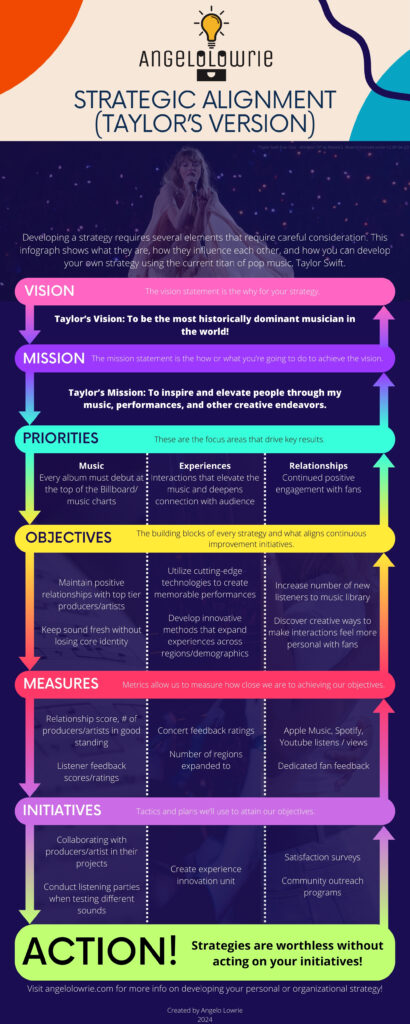Love her or hate her, there’s no disputing that Taylor Swift has been the dominant female performing artist in 2023 and, quite possibly, in history. Let’s look at some stats:
- Time Magazine’s person of the year for 2023
- Named top artist in 2023 by Spotify and Apple Music
- 14 Grammys, 40 American Music Awards, 39 Billboard Music Awards as of 2024
- Only female artist to have three #1 albums on Billboard in a calendar year
- Boosted U.S. economy by $5.7 billion through her Eras tour which earned $4.1 billion
There are many more records sheft has broken with no reason to believe she won’t break more considering she is still in her early thirties.
I’m not here to stan T. Swift, though. What I want to look at is her strategy and how she aligned her priorities to achieve her dominant status to show you how to create your own. What I want to do is encapsulate her monumental accomplishments into a military-like strategic alignment framework to show how you can use the same principles for your organization or personal endeavors.
A strategy several core components. The vision statement (why we’re doing this), mission statement (what we do), priorities (our primary focus areas), objectives (how we’re going to accomplish priority results), performance measures (data), and initiatives (plans of action).
To help wrap your head around these components, let’s take a look at how Taylor Swift and her management team could have aligned her strategy.
Vision

The vision statement is the why for your strategy. This is the guiding light, the north start that always steers you towards the destination you seek. It should be succinct, easy to remember, and emotionally inspirational. Here’s what how I would frame Taylor’s vision statement:
Taylor’s Vision: To be the most historically dominant musician in the world
One could argue that this could be simplified to “to be the most dominant musician”, but adding “historically” makes the vision more enduring and elevates the target, while “in the world” ensures that we aren’t just talking about a specific region, like the U.S., Europe, etc.
Mission

The mission statement is the how or what you’re going to do to achieve the vision. It simply states “This is who we are, what we’re about and what we do.” Look up any company’s “About Us” page and you’ll see there mission statement.
Taylor’s Mission: To inspire and elevate people through my music, performances, and other creative endeavors.
Again, we keep it simple, easy to understand, and relevant to what she does. A mission statement doesn’t have to be verbose, and in all honesty the ones that have a lot of fluff can be a sign that the organization could be overextending it’s strategy.
Priorities

These are the focus areas that drive key results and enables everyone in your organization to understand what they need to achieve.
Taylor’s Priorities: Music, Experiences, Relationships
Each priority should have a desired outcome defined. So let’s break it down some more
Music – Every album must debut at the top of the Billboard/ music charts
Experiences – Interactions that elevate the music and further develops the connection between the audience
Relationships – Continued positive engagement with fans
Objectives

Now we’re getting to the meat of the strategy by laying out the key components of the strategy. Objectives are the building blocks of every strategy, and that aligns continuous improvement initiatives. Each priority will have their own set of objectives, but you don’t want to have too many objectives to the point where they are not attainable for your strategy.
Taylor’s Objectives:
Music
- Maintain positive relationships with top tier producers/artists
- Keep sound fresh without losing core sound identity
Experiences
- Utilize cutting-edge technologies to create memorable performances
- Develop innovative methods that expand experiences across regions/demographics
Relationships
- Create a pipeline that funnels new listeners towards greater music catalog
- Discover creative ways to make interactions feel more personal with fans
Measures

What gets measured gets done and that holds true in every strategy. Songs streamed, album ratings, ticket sales, etc. are all examples of metrics that assist us with determining how we’re doing in achieving our objectives. It’s important that the measures tie back to the objectives. In agile, these are also known as key performance indicators (KPIs).
Taylor’s Measures:
Music
- Relationship score, # of producers/artists in good standing
- Listener feedback scores/ratings
Experiences
- Concert feedback ratings
- number of regions expanded to
Relationships
- Apple Music, Spotify, Youtube listens / views
- Swifty feedback
Initiatives
Once we’ve determined the measures we’ll use to gauge success in our objectives, we can determine initiatives that help us to get to the desired measures. This is where action plans are developed and we determine the tactics we’ll use for each objective in our strategy.
Taylor’s Initiatives
Music
- Collaborating with producers/artist in their projects
- Conduct listening parties when testing different sounds
Experiences
- Create experience innovation unit
Relationships
- Satisfaction surveys
- Community outreach programs
Putting the Pieces Together
All these elements make up a strategy. In order for it to be executed correctly they must logically flow up and down the chain. Meaning that someone could follow from the vision down to an initiative and understand how carrying out that initiative helps the overall vision. The infographic below provides a visual example of how the strategy comes together.

Action!
You can’t achieve victory without moving on your strategy. Sure, you’ll also avoid losses, but might as well stay out the game at that point. Not every strategy will be successful. Sometimes we get the vector wrong at the very beginning by not identifying the correct objectives, but you won’t know that unless you take action and do things. Sometimes the greatest opponent to a strategy isn’t your opponent, but your inaction.
If Taylor Swift didn’t make music, she’d be chilling at home like the rest of us, listening to someone else’s song play through her speakers.
Conclusion
Asserting Taylor Swift dominance isn’t easy, takes time, and can only be achieved with an enduring strategy. One thing Taylor and her management team has done so well is remaining faithful to the one they crafted. While they may not have taken the military like approach by breaking it down by using these elements, you can use this example to craft one of your own.
If you want to attain the type of dominance she has, carefully create your strategy, and remember to take action!


Comments
One response to “Strategic Alignment: Achieving Taylor Swift Dominance”
Hi, this is a comment.
To get started with moderating, editing, and deleting comments, please visit the Comments screen in the dashboard.
Commenter avatars come from Gravatar.